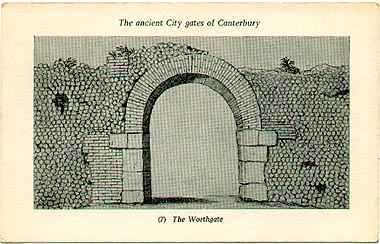|
Wincheap Gate (now destroyed) |
|
|
Roman: "Had [it] survived it would have been
one of the most remarkable Roman remains in the country"
|
|
|
|
|
|
Postcard from a set of 'Ancient gates of Canterbury',
and drawing. |
|
|
Notes - taken from William
Urry's account (1948):
|
|
|
This was indisputably a Roman structure, having an arch of tiles (estimated at 100 in number) with massive stone jambs, possibly of oolite. The medieval form of the name was Worgate, but by the 16th century 'th' had intruded into the name, probably on analogy with the Kentish village name of Worth, which led the antiquaries to imagine the name as derived from the Anglo-Saxon 'worth' meaning a stronghold, because of the adjacent Castle. However, one of the great mysteries of borough history in the Anglo-Saxon period is the fact that villages surrounding a given town seem to have maintained some sort of connection with houses inside it. 'Worgate' is a contracted version of a form Wi-wara-gát, that is, the gate of the men of Wye, so it looks as though their town housing must have clustered round this area. Had the arch of Worthgate survived it would have been one of the most remarkable Roman remains in the country. Its sombre impressiveness was much commented upon [Here he gives the dimensions... if you want them, let me know] When the Castle was established here in the time of William the Conqueror, Worthgate became one of the Castle Gates. Perhaps it was provided with some defensive towers, as the space around it, where the Alderman of the Ward held his court, was known as the Barbican, which indicates more than a mere arch. No trace of such tower has existed for centuries however. After the demolition of Worthgate in 1791, its remains were transported
to Lee Priory at Littlebourne, where it was re-erected. It disappeared
in a subsequent rebuilding of the house. |




